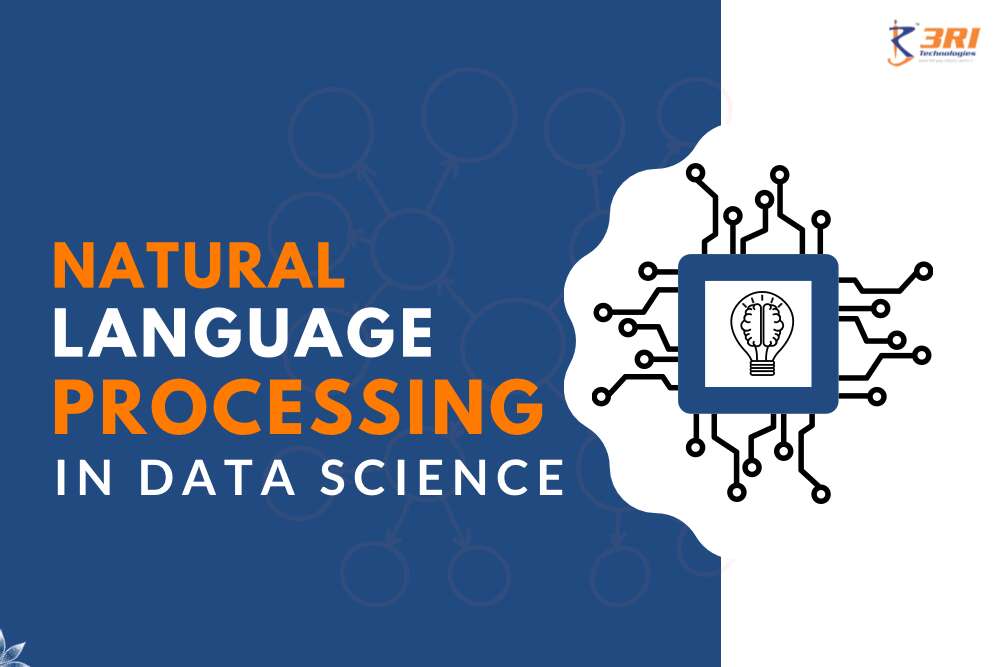Introduction:
Natural Language Processing (NLP) has become a game-changing technology in the field of data science, revolutionising how unstructured text data is processed and analysed. Data scientists with NLP expertise are at the forefront of deriving significant insights from language-based data due to the increasing rise of textual data in numerous sectors. In this blog post, we examine the role of NLP in Data Science, examining its uses, advantages, and priceless contributions to the discipline.
The world is changing swiftly, which is causing significant growth in the use of data. This information is primarily in a format of text and must be processed. Natural Language Processing (NLP) is a branch of computational intelligence that assists data analysts in extracting significant information from text-based data. This is why NLP professionals are in high demand. Using many different languages, tones, and phrases to retrieve information from the computer is quite challenging.
There is a great amount of unstructured data that is generated daily, but with advanced data science and NLP, machines can have meaningful conversations with people. NLP or Natural Language Processing studies the interaction of languages and computers and they program a device to understand language as it is spoken. It is mainly used by smartphone assistants, chatbots, or translation software besides numerous other business apps. NLP techniques understand written text and human speech and assist in big data integration.
Due to the abundance of unstructured text data, NLP plays a role in data science. We discover that, as we explore the close connection between NLP and data science and the enormous potential they hold together, Data Scientists use NLP to analyse, evaluate, and draw important insights from the language processing of data.

Want Free Career Counseling?
Just fill in your details, and one of our expert will call you !
What is Natural Language Processing?
Natural Language Processing allows computers to comprehend, determine, and produce language that humans use. It combines computer science and language to process speech and data. The process includes text cleaning, data processing, tokenization, and removal of punctuation. NLP uses various techniques to analyze the grammar and structure of the sentences and parsing to understand the word relationship. It also performs sentiment analysis to determine the emotional tone of the text and performs named entity recognition to identify dates, names, and locations.
Machine Learning Models like RNNs or BERT are used to extract insights from data, translate languages, and summarize the text to answer the questions. These models comprehend large amounts of data and with experience, it improves. NLP also makes various languages interpretable to machines and enables applications like language translation, chatbots, information retrieval, and sentiment analysis. During the development phase, NLP applications are challenging as human interaction with computers using Python and Java is needed. Spoken languages by humans are ambiguous and vary with regions, which makes it difficult for computers to understand these natural languages. NLP comprehends the languages and interprets them easily, making them easier for chatbots to understand and respond to.
What is NLP in Data Science?
NLP is primarily a branch of AI that aims to make it possible for machines to understand, interpret, and generate human language. NLP is a broad category of methods and algorithms that Data Scientists can use to process, examine, and extract useful information from unstructured text data. It makes it possible to transform textual data into a structured format suitable for advanced analytics, enabling the use of data in decision-making.

NLP’s Role in Data Science
Text Preprocessing: Natural Language Processing, an essential component of the subject, enables data scientists to examine, analyse, and draw conclusions from text data. NLP techniques span a wide range of tasks, starting with text preprocessing, where unstructured content is transformed into a structured format suitable for analysis. Tokenization, stemming, removing stop words and punctuation, among other methods, are used in this.
Text Classification: NLP enables a number of tasks, including text categorization, sentiment analysis, and named entity recognition, after the text has been pre-processed. NLP Data Scientists can automate procedures like topic categorization, sentiment analysis, and document classification by classifying text into predetermined categories.
Sentiment Analysis: In contrast, sentiment analysis makes it possible to identify the emotional undertone of a text, which is useful for understanding customer feedback, managing a brand’s reputation, and conducting market research.
Named Entity Recognition: Named entity recognition involves finding and organising named entities inside text, such as names of individuals, organisations, and places, to assist in information extraction and knowledge graph creation.
Language Translation: NLP, which is equally significant in language translation, allows for the construction of systems that automatically translate text from one language to another. This has significant implications for cross-cultural research, global interactions, and the availability of information in several languages. Looking forward to becoming an expert in Data Science? Then get certified with Data Science And Machine Learning Course.
Text Generation: NLP techniques enable text generation, where language models are used to produce human-like text. This has applications in content creation, automated writing, and chatbot interactions.
Question Answering Systems: NLP contributes to tasks like question answering systems, where natural language queries are processed to provide relevant and accurate responses.
Text Summarization: NLP facilitates text summarization, condensing large volumes of text into concise summaries, which is beneficial for news aggregation, document summarization, and information retrieval.
Social Media Analysis: NLP techniques are also utilised in social media analysis to draw conclusions, identify sentiment patterns, and analyse user behaviour.
Speech Recognition and Processing: NLP enables voice processing and recognition, enabling Data Scientists to translate spoken words into written text and do further research. This is essential to applications like voice assistants, speech-activated devices and transcription services.
Multilingual NLP: NLP techniques can be used to manage and analyse text across multiple languages; they are not restricted to English or any other particular language. NLP Data Scientist can overcome the difficulties of analysing text in several languages with the help of multilingual NLP, facilitating global corporate operations, market research, and customer support.
Ethical Considerations: NLP is useful for dealing with ethical problems in the data science industry. NLP Data Scientists must take a range of actions to eliminate biases in data, protect privacy and data, encourage the responsible use of language models, and contribute towards transparency, justice, and non-discrimination in NLP applications. It is necessary to conduct constant oversight and evaluation in order for the use of NLP technology to be ethical and impartial.

Book Your Time-slot for Counselling !
NLP Techniques in Data Science
Here are some key techniques that are basics in Data Science to extract insights:
- Stemming and Lemmatization: These techniques reduce the words into root forms. Stemming cuts off prefixes and suffixes and lemmatization pays attention to grammar and context. They help in the normalization of text as stemming works on the principle that particular words with somewhat different spellings but the same meaning need to be placed in the same token. Affixes are removed in stemming for efficient processing. Lemmatization converts words into lemma, a type of dictionary representation of the term. This technique converts various forms of words to the root form and groups them. Although the main aims of these techniques are similar they have different approaches.
- Stop word removal: Common words like “and” and “the” that don’t have a particular meaning are known as stop words. Noise is reduced in text data with its removal. In this technique, these common words occur frequently but add no or little value to the results. They are automatically removed from the text to free up the space. This enhances the performance and processing time. This technique helps minimize the noise so that focus can be laid on important and meaningful words during analysis. Common prepositions are also removed in this technique but it is not preferred much in analysis as some crucial information may be lost in the process.
- Term Frequency-Inverse Document Frequency (TF-IDF): In this NLP approach, the relevance of a phrase in a text is measured across a group of docs. It aids in the identification of phrases and keywords in text. TF or Term Frequency quantifies the frequency of a specific word in a given text which is measured by counting the word occurrences of a word in the document and dividing it by the length of the document. Inverse Document Frequency or IDF allocates the significance to any string based on its importance. It computes it by dividing the total amount of pages in the set of data at the time by the total amount of documents including that specific term. The significance of any word is calculated via the multiplication of the TF and IDF terms, i.e. TF*IDF. By using these data, the words with greater relevance are awarded more importance by this technique. This approach is used consistently by search engines to rank and score the relevance of every data based on supplied keywords.
- Keyword extraction: This technique includes the process of identifying the most significant words or phrases in the content called keyword extraction. It is crucial for summarizing, searching, and analyzing various topics. This technique is a text-analysis approach that helps in the extraction of the most constantly used and essential words and expressions from the provided text. It summarizes textual information and identifies the primary issues presented. It extracts keywords from provided content like conventional papers and reports on organizations, messages, social media comments, online discussions and reviews, news articles, etc. We can identify instantly what our clients are referencing consistently on the internet by using the method of Keyword extraction. The teams can save hours of manual processing by using traditional techniques. Businesses require automatic extraction of keywords so that they can analyze and handle the data effectively as about 80% of created data remains unorganized, which makes it quite difficult to process and analyze.
- Word Embeddings: Word embeddings like Word2Vec and GloVe turn words in heavy matrices into continual vector domains. This helps robots to comprehend the semantic linkage within words. The word embedding technique of NLP is an approach used to numerically express the words of a document. This must be stated in such a way that equivalent phrases are displayed identically. Particular words from a dialect or field are displayed as vectors with real values in the least dimensional areas. This manner of modeling documents and words is a basic success in deep learning of difficult NLP tasks. Every word is represented as an actual values vector that may have tens or hundreds of units.
6. Topic Modeling: Techniques like Latent Dirichlet Allocation (LDA) and Non-Negative Matrix Factorization (NMF) are utilized to look for hidden subjects in a collection of text data. This aids in the classification and recommendation of content. This NLP technique extracts relevant themes from a document or text. It operates on the premise that every document is a collection of subjects and each topic is a collection of words that are correlated with dimensionality reduction
7. Text Preprocessing: NLP techniques such as tokenization, stemming, and lemmatization play a crucial role in preparing textual data for analysis. By eliminating redundant information and standardised language, these strategies assist Data Scientists in converting unstructured text into structured units, enhancing the effectiveness and precision of subsequent analysis.
8 . Sentiment Analysis: Due to NLP, Data Scientists can now examine and understand the sentiment present in textual data. Using sentiment analysis algorithms, Data Scientist NLP may automatically classify information as positive, negative, or neutral, providing them with insights into customer feedback, brand perception, and market trends. Sentiment analysis has several uses, including managing brand reputation, analysing customer feedback, and monitoring social media.
Sky Rocket your career with our course Data Engineering Training with Placement
9 . Named Entity Recognition (NER): Using the essential NLP technique known as NER, Data Scientists may locate and classify named entities, such as individuals, groups, locations, and dates, within text. Besides, Data scientists can do activities like market analysis, consumer profiling, and information extraction by gaining deeper insights into relationships, patterns, and trends through the extraction of these entities. NER is especially helpful in industries like healthcare, banking, and law, where accurate entity identification is essential.
10 . Text Classification: Data Scientists can use NLP approaches to classify text into specified groupings or categories. Textual data may be efficiently organised and retrieved using text classification algorithms, which automate processes like subject identification, document categorization, and sentiment labelling. Spam detection, news categorization, and client segmentation are just a few of the numerous applications for text classification.
11 . Language Translation: NLP, which is important in language translation, allows data scientists to build systems that automatically translate text between languages. This ability encourages cross-cultural communication, streamlines multilingual analysis, and expands information accessibility. Language translation is essential to multinational collaborations, international business, and multilingual customer service .Become a PRO Data Analyst with Data Analyst Course in Pune
The Data Scientist’s Role in NLP
Data Scientists with NLP expertise are leading the way in utilising the value of language-based data. They possess the knowledge required to create and implement NLP algorithms, evaluate the efficiency of models, and analyse the results. They have a larger role than just data analysis; they also contribute to innovation, better user experiences, and strategic decision-making. Several industries, including e-commerce, healthcare, finance, and marketing, are in need of Data Scientists with NLP expertise.

Meet the industry person, to clear your doubts !
Benefits of NLP in Data Science
a. Efficiency: NLP automates the examination of massive amounts of text data, saving data scientists both time and money. Manually analysing unstructured text takes time and is prone to mistakes, while NLP approaches make the process faster and allow for scale analysis.
b. Insight Extraction: NLP has made it possible for Data Scientists to extract useful information from language-based data. Besides, Data scientists can find patterns, trends, and linkages that guide wise decision-making by examining feelings, extracting named things, and categorising text.
c. Unstructured Data Analysis: Unstructured text data can sometimes be quite informative, such as in service requests, social media posts and consumer reviews. NLP allows Data Scientists to analyze this unstructured data, providing valuable insights that were previously untapped.
d. Personalized Experiences: Data scientists can utilise NLP to provide specified observations and a better understanding of customer preferences. Companies that examine customer feedback, sentiment, and interaction data can tailor their products and services to enhance customer satisfaction and loyalty.
e. Competitive Advantage: NLP equips organizations with a competitive edge by enabling them to leverage the vast amount of textual data available. Businesses may use the potency of NLP to acquire insights into market trends, consumer attitudes, and competition strategies, enabling them to make data-driven decisions and outperform their competitors.
Check out the Data Science online training and get certified today.
Challenges in NLP for Data Science:
While NLP has achieved significant advancements, it still faces several challenges that Data Scientists must overcome to maximize its potential.
Ambiguity and Polysemy: Natural language frequently contains words with various meanings and is inherently ambiguous and context-dependent. NLP models may interpret data incorrectly as a result of this multilingualism, particularly when performing tasks like sentiment analysis and word sense disambiguation. Algorithms that can precisely determine the correct meaning based on context must be created by data scientists.
Data Quality and Quantity: NLP models heavily rely on large amounts of good training data to generalise well. However, collecting and categorising a lot of text data might take a lot of time and resources. Additionally, biased or noisy data can reduce the efficacy of NLP models. Data scientists must employ strategies like data augmentation and transfer learning in order to get around data limitations and increase model resilience.
Domain Adaptation: When used in a new domain, NLP models that have been trained on one domain may not perform as well. For instance, applying sentiment analysis algorithms developed using social media data to financial news may not be successful. In order to fine-tune models for particular domains and improve generalisation and accuracy, domain adaptation approaches are crucial.
Multilingual Challenges: While multilingual NLP is a crucial component of Data Science, analysing text in several languages poses special difficulties. Data Scientists must create sophisticated methodologies that can manage a wide range of linguistic features due to language-specific nuances, the absence of labelled data for low-resource languages, and different grammatical structures.
Bias and Fairness: NLP models may unintentionally reinforce biases found in training data, leading to unjust and discriminating outcomes. Eliminating bias in NLP models is a critical ethical concern for data scientists. Adversarial debiasing and attention methods are two techniques that can be utilised in NLP applications to lessen bias and ensure fairness.
Interested to begin a career in Data Analytics? Enroll now for Data Analytics Course in Pune.
Future Directions of NLP in Data Science:
The future of NLP in Data Science promises exciting advancements and expanded applications. Here are some potential future directions:
Explainable NLP Models: The interpretability of NLP models will remain a focus of research to increase trust and transparency. Data scientists will continue to explore methods to make deep learning models more explainable, allowing stakeholders to understand the reasoning behind model predictions.
Contextual Understanding: Improving the ability of NLP models to comprehend context and context shifts will be a significant area of development. Leveraging contextual embeddings and transformer-based models, data scientists aim to enhance language models’ contextual understanding, enabling more accurate and context-aware language generation.
Integrating Vision and Language: The fusion of NLP with computer vision will lead to advanced multimodal AI systems. Combining language and visual information will enable data scientists to develop models capable of understanding and generating rich, multimodal content, opening up new possibilities in areas like image captioning, visual question answering, and image-text generation.
Few-Shot and Zero-Shot Learning: Research into few-shot and zero-shot learning aims to reduce the reliance on vast amounts of labeled training data. Data scientists are exploring ways to train NLP models with minimal supervision, allowing them to generalize to new tasks and languages with limited data.
Pre-trained Language Models: Pre-trained language models, such as GPT-3 and BERT, have shown exceptional performance in various NLP tasks. The future will see more extensive pre-training on larger datasets and domain-specific corpora, paving the way for highly effective and adaptable NLP models.
Emotion and Contextual Analysis: Expanding NLP models to recognize emotions and emotional context will revolutionize human-computer interactions. Data Scientists are investigating ways to imbue NLP models with emotional intelligence, enabling them to respond appropriately to users’ emotions and intentions.
Conversational AI: Advancements in NLP will continue to drive the development of more sophisticated conversational AI systems. Data Scientists aim to create chatbots and virtual assistants that can engage in natural, contextually relevant conversations, providing personalized and human-like interactions.
Natural Language Processing and Big Data:
Natural Language Processing and Big Data are related fields of the modern day and Big Data has a large amount of speech and text data that are required for NLP applications. NLP extracts valuable insights from unstructured text data to enhance Big Data analytics. Every day, vast amounts of data are created, which Big Data stores and processes.
The algorithms of NLP analyze the data and extract trends, sentiments, and patterns. NLP is used by various social media platforms to understand the sentiments of users and perform target advertising. NLP also retrieves information from large datasets so that they are easier to search, categorize, and summarize large amounts of text information. It is a crucial part of business intelligence, content recommendation systems, and customer feedback analysis. NLP and Big Data supplement each other and enable companies to extract valuable information from large amounts of textual data available in the digital world.
This results in enhanced choices and better experiences for users. Natural Language Processing depends on Big data and this technology enhances the efficiency and capability of big data. The most commonly used NLP technique is lexical analysis which identifies and analyzes the sentence structure.
Common use cases of NLP(Natural Language Processing):
There are a wide range of uses of Natural Language Processing and some of the cases include:
- Virtual assistants and chatbots: NLP is used by chatbots that use natural language to interact with users. They are used to automate tasks, for customer support, and in providing information. Chatbots are artificial intelligence programs that imitate chat or human conversation and use NLP to understand common human languages.
- Sentiment Analysis: NLP is used by organizations to analyze customer reviews, feedback, and social media mentions to receive public sentiments about their services and products. It processes the text to understand the sentiments of the writer during text classification.
- Language Translation: NLP is used in translation services like Google Translate which translates the text between languages without human involvement. There are deep learning networks that translate the source text based on localization and context of the text.
- Text Summarization and Classification: NLP automatically generates concise summaries of long documents and articles that help in the retrieval of information. The main task of NLP is to read the text and summarize and classify it.
- Information extraction and speech recognition: NLP extracts structured information from unstructured text like converting resumes into structured data to match jobs. Natural language comprehension and recognition of speech are used by voice assistants such as Alexa and Siri.
- Healthcare sector: NLP is widely used in healthcare as it helps extract insights from medical records and helps healthcare providers make decisions.
- Recommendation of content: NLP helps in personalizing the recommendation of content on OTT platforms or Music apps.
- Named entity recognition: NLP recognizes named entities from text data and classifies them into pre-defined categories. These include names of individuals, universities they have attended, and the companies they were employed in along with dates and duration.
- Text Mining: By converting content into information, you may find valuable data in it. Numerous tools give detailed information about the given text and highlight patterns in the extensive data set.
- Predictive text modeling: NLP performs this through its algorithms that predict the upcoming word of the sentence by understanding its localized context.
- Recommender systems: NLP has content-based recommender systems that offer suggestions for relevant items for the user and they rely on approaches like user-user similarity and item-item similarity.
Natural Language Processing and the Future of Big Data:
The market for software apps using NLP and artificial intelligence is expected to increase in the future. There are numerous possibilities for big data and it powers endless industries. In the coming future, the healthcare industry will reap dramatic benefits from Natural Language Processing and data integration.
There will be better communication with reduced errors and improved diagnosis with healthcare software that understands and integrates doctors’ notes, patients’ voicemails, and phone calls easily. NLP is also widely used by medical researchers and pharmaceutical companies as they have a large amount of text data like patient notes and clinical trial information. Tools like automatic summarization can help in analyzing information.
The field of law enforcement can gain benefits from NLP as it understands and integrates language-turned data from anonymous phone calls, criminal records, and social media posts. Legal organizations can get NLP benefits from numerous pages of legal documents, police reports, stenographer notes, and police reports as they are easily summarized. NLP processes like automatic summarization aid in the analysis of large amounts of text data and deriving a summary. This is helpful to numerous industries with improved NLP capabilities as numerous big data processes require the translation of information from humans to computers for decision-making and analysis.
Real-Life NLP Case Studies:
ChatGPT by OpenAI: It is widely used by organizations to provide automatic customer support. It understands customer queries and responds to them by resolving basic problems and sending complex queries to human customer support.
Netflix’s system of recommendation: Netflix uses NLP to analyze the provided comments and reviews. This improves the recommendation of content and ensures that users can easily find movies and shows as per their preferences.
Analysis of medical records: Health centers use NLP to receive valuable insights from EHRs or electronic health records. This helps in disease tracking, decision support, and identification of trends in a patient.
Legal documents review: NLP is used by law firms for the review of documents and it goes through a large amount of legal documents quickly to recognize relevant information.
Conclusion:
In conclusion, Natural Language Processing (NLP) plays a pivotal and multifaceted role in the field of Data Science. It serves as a transformative tool that empowers data scientists to unlock the wealth of information hidden within unstructured text data. Through a range of techniques and algorithms, NLP enables the extraction of valuable insights, automation of processes, and informed decision-making. Check 3RI Technologies
Data Science NLP has a wide range of real-world applications. From the initial step of text preprocessing, where unstructured text is transformed into a structured format suitable for analysis, to tasks such as text classification, sentiment analysis, named entity recognition, language translation, and text generation, NLP enables Data Scientists to uncover patterns, trends, and relationships in language-based data. It facilitates efficient organization and retrieval of textual information, aids in understanding customer opinions and sentiments, enhances brand reputation management, and enables personalized experiences.
However, the Role of NLP in Data Science is not without its challenges and ethical considerations. Data Scientists must grapple with issues such as biases in data, ensuring privacy and data protection, promoting responsible use of language models, and striving for transparency and fairness in NLP applications. The responsible and unbiased use of NLP Data Science technologies necessitates the establishment of ethical guidelines, continuous monitoring, and evaluation.

Do you want to book a FREE Demo Session?
Looking ahead, the future of NLP in Data Science holds great promise. Advancements in explainable NLP models, contextual understanding, integration of vision and language, pre-trained language models, emotion and contextual analysis, and conversational AI will shape the trajectory of NLP. These developments will pave the way for more sophisticated, accurate, and context-aware NLP models that can truly understand, generate, and interact with human language.
In conclusion, NLP is vital and cutting-edge data science technology. Its ability to unlock valuable insights from unstructured text data, automate processes, and facilitate data-driven decision-making has made it indispensable in various industries Though challenges and ethical considerations still exist, NLP is developing at a rapid rate, spurring innovation and influencing the direction of AI. With responsible use and ongoing advancements, NLP will continue to revolutionize industries, improve decision-making processes, and transform the way we interact with machines. If you wish to pursue a Data Science Course in Pune, then you can always drop by 3RI Technologies.

